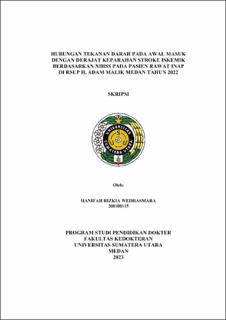| dc.description.abstract | Background. Ischaemic stroke is a neurological deficit disorder characterized by
a blockage of blood vessels in the brain. The multiple risk factors including high
blood pressure can lead to different degrees of stroke severity. The gold standard
parameter in determining stroke severity is using the National Institute of Health
Stroke Scale (NIHSS). Aim. To analyze the relationship between initial admission
blood pressure and severity of ischaemic stroke based on NIHSS in hospitalized
patients at Haji Adam Malik Hospital Medan in 2022. Methods. This study is an
observational analytical research with a cross sectional study design. The sample
of this study were ischaemic stroke patients who were hospitalized at Haji Adam
Malik Medan Hospital in 2022 and selected using purposive sampling method.
After calculating using the Slovin formula, the number of samples needed was 120
samples. The data used is obtained from patient medical records. The analysis used
is univariate and bivariate analysis with Chi-Square. Results. Of the 120 patients,
64 patients (53.3%) were male, 83 patients (69.2%) were aged >55 years. There
were 79 patients (65.8%) without a history of DM, 76 patients (63.3%) had
moderate stroke, and 30 patients (25%) had grade 1 hypertension. Statistical
analysis showed an association between initial admission blood pressure and the
severity of ischemic stroke based on NIHSS (stage 1 hypertension (P=0,005;
OR=4,38), stage 2 hypertension (P<0,001; OR=8,76), stage 3 hypertension
(P<0,001; OR=19,71)). Conclusion. There is a significant association between
initial admission blood pressure and severity of ischemic stroke based on NIHSS. | en_US |


